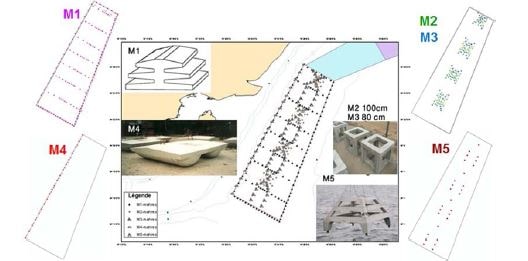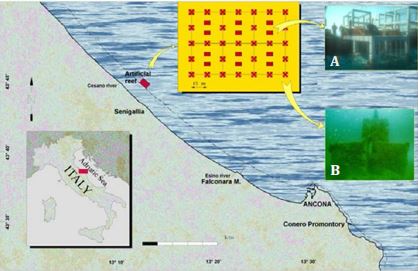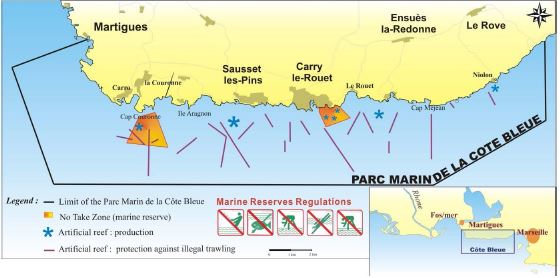5.5. Multipurpose artificial reefs
5.5.1 Objective
To maximise the benefits from the construction of an artificial reef and reduce the costs, the reef is often planned to achieve more than one purpose. In this case it is called “multipurpose artificial reef”.
However, not all the functions of artificial reefs described above are compatible with each other. For example, in Australia there has been evidence that recreational line fishing and diving (primarily scuba diving) on artificial reefs were in direct conflict with each other and created some resource allocation issues. This has also been the case for intersector conflicts between spearfishers and line fishers. The most common application of multipurpose artificial reefs in the Mediterranean Sea combines the protection and production functions.
5.5.2.Design
A multipurpose artificial reef should include modules of different types or, alternatively, adequately designed reef units/reef sets. For example, an artificial reef for protection and production purposes could include both units acting as deterrents to illegal fishing and structures (units and/or sets) aimed to increase the biomass in the area. Alternatively, it can be constructed with modules/sets that perform both the functions (Fig. 13). In this case, mixed units are basically composed of protection modules with some characteristics of production such as small cavities or surfaces for the settlement of benthic organisms or eggs. Similarly, a production and recreational artificial reef can include both structures to increase the biomass and shipwrecks.

Figure 13. Examples of multipurpose artificial modules: A) Spain; B) Italy; C) Tunisia (modified from J.J. Goutayer?Garcia, CNR?ISMAR Ancona and N. Haddad).
5.5.3.Siting
The arrangement of the structures inside a multipurpose artificial reef depends on the purposes of the reef. For protection and production reefs, the protection units should be placed along the perimeter of the reef area and the production structures in the centre. The same should apply to artificial reefs created for protection, production and recreational purposes.
5.5.4.Practical applications
The most common examples of multipurpose artificial reefs are found in Italy, Greece, Spain and Tunisia.
? Protection and production
Italy – Since the 1970s, artificial reefs have been deployed along the Italian coastal waters to protect coastal habitats and fishing communities against illegal trawling and to enhance small?scale fisheries. Along the Adriatic Sea, where there is an important clam fishery (Chamelea gallina) operating with hydraulic dredges on sandy?mud bottoms located in shallow water up to about 11 m depth, small?scale fisheries are often in conflict with both illegal trawling – due to competition over the resources and the damage made to set gear – and hydraulic dredges – due to competition over space and damage to the gear. The strategy adopted to reduce these conflicts was to allocate space and resources to the construction of large?scale multipurpose (anti?trawling and production) artificial reefs at around 5.5 km offshore. The deployed modules can be gathered into three main groups: a) protection modules, b) production modules and c) mixed modules.
Anti?trawling structures associated with production units or mixed modules (Fig. 17) were used (Bombace et al., 2000; Fabi, 2006; Fabi et al., 2006). As trawlers are used to begin their hauls outside the 5.5 km zone and to penetrate the prohibited area perpendicularly to the shoreline, these reefs consist of rectangular zones, as long as possible, which are placed horizontally with respect to the coast. The distance between the modules was calculated on the basis of otter?board openings (Fig. 14). These artificial reefs contributed to reduce conflicts between fishers as they created a suitable area where small?scale fishers could carry out their seasonal activities according to the eco?ethology of the different species inhabiting the reef, often gathering in cooperatives to manage the reef areas and their resources.

Figure 14. Examples of multipurpose artificial reefs deployed along the northern and central Adriatic coast, Italy (courtesy of CNR?ISMAR Ancona).
Spain – Similar strategies have been adopted along the Spanish Mediterranean coasts since the late 1980s with the aim of creating suitable grounds for selective small?scale fisheries and protecting them from other less selective fishing activities (trawling and seines), hence improving marine communities and preventing conflicts between fisheries. In this case too, protection, production and mixed modules were used and displaced to prevent trawling, regardless of the fishing vessels route (Fig. 15) (Moreno, 2000; Ramos?Espla et al., 2000).

Figure 15. Example of a protection and production artificial reef (El Campello, Spain) realised with anti?trawling and mixed modules: A) plan of the artificial reef; B) protection unit; C) attraction/concentration set and displacement of the units inside a reef set (from Ramos?Espla et al., 2000).
Tunisia – In Tunisia there has been an increase in overfishing due to the introduction of large trawlers and a progressive decline of Posidonia meadows caused by the illegal activities of small?sized trawlers in coastal areas. Over the past ten years, these factors have led to a gradual decrease of demersal resources with a consequent reduction of the income of small? scale fishers. Moreover, it has been estimated that around 90 percent of seagrass beds, which represent important spawning and nursery areas for several coastal fishing resources, have disappeared in the Gulf of Gabes. To solve these problems, the Tunisian Government adopted in 2002 a management policy towards regulating fishing practices in order to maintain the balance between fishing pressure and exploitable fishing resources. The programme also included the adoption of active measures to protect and restore marine habitats on fishing grounds, enhance fishing resources and diversify small?scale activities. One of the most relevant management measures was the construction of protection and production artificial reefs. Most artificial reefs consisted of simple concrete blocks with iron bars to stop illegal trawling and, in some cases, with internal holes or bricks to give shelter to marine organisms. These reef modules were directly constructed by fishers. More recently, a new design has been adopted, which has allowed the construction of more complex multipurpose artificial reefs (protection and production). These new artificial reefs (Fig. 16) include modules for the production of algae, which also have a protection function (M1); production modules of different dimensions (M2 and M3); protection modules (M4) and modules for reproduction and nursery purposes (M5).

Figure 16. Plan of the multipurpose artificial reef Mahres 3 (Gulf of Gabes, Tunisia) (modified from N. Haddad).
? Protection, production and extensive aquaculture
Italy – Artificial reefs have been deployed within the coastal area of the northern Adriatic Sea by local small?scale fishers associations in order to optimize their activity by creating suitable habitats for reef?dwelling fish and macroinvertebrates, and favouring the development of wild mussel populations. In this case, the reef sets were composed of two types of mixed modules: A) production and aquaculture; B) protection and production (Fig. 17).

Figure 17. Example of multipurpose artificial reef (protection, production and extensive aquaculture), Italy. A) production and extensive aquaculture reef sets; B) protection and production reef set (courtesy of CNR?ISMAR Ancona).
These artificial reefs were usually placed close to the coast and in shallow waters (approximately 10 m depth) to facilitate mussel harvesting by professional scuba divers.
? Protection, production artificial reefs and MPAs
Artificial reefs can also be associated with MPAs.
France – From 1983 to 2004, 4 884 m3 of production and protection artificial structures (2 684 m3 and 2 200 m3 respectively) have been deployed in the Cote bleue marine park (Fig. 18). Part of these man?made structures were placed within and around two no?take zones that are marine reserves of 295 ha where all kinds of fishing activities, scuba diving and mooring are prohibited. In this case, the establishment of the MPA and the deployment of artificial reefs were used as complementary tools which contributed to preserve traditional small?scale fisheries allowing all local fishers (around 60) to fish in the area, including after the establishment of the MPA. Conversely, these fishing activities have been decreasing in the nearby zones (Charbonnel and Bachet, 2011).

Figure 18. Multipurpose artificial reefs associated with MPAs. Case of the Cote bleue marine Park, France (from Charbonnel and Bachet, 2011).